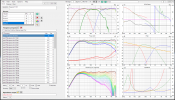Has anybody taken ground plane measurements at around the 5:1 suggested limit (10m for a 2m measurement or 5m for a 1m measurement to the nearest wall) to see the effect that first reflection actually has? Is it large enough to give up better bass resolution by not including it? Even if 1 dB errors occurred (I assume mainly in the bass region?) may that still not be more accurate than nearfield sums and a calculated baffle step (all of which can be prone to errors, time consuming and very difficult to do, depending upon the speaker)?
If I had access to such a hall, I would also experiment with GP measurements

You can consider a very rough theoretical worst case for your hall:
When measuring without a gate, there are coherent reflections, especially in the bass range, in a hall with smooth walls.
Depending on the frequency and the phase shift of the reflections compared to the loudspeaker signal at the measurement microphone, in the worst case there can be optimal addition or cancellation of source and reflections.
If we assume that the loudspeaker is located in the center of the room and the distance to the outer walls of the hall is approximately the same (we simply ignore the reflection from the hall floor and ceiling

) and let's further assume that the distance to the walls is 8m each and the loudspeaker is measured at a distance of 1m.
Each reflection arriving at the mic has traveled a distance of 8+8m (roughly rounded). The reflection has a -6dB*4 lower sound pressure than the source (loudspeaker) at the measurement microphone. We are only interested in the four first-order reflections from the walls.
If our measurement signal from the loudspeaker arrives at the mic with 90dB, then the reflections arrive with 90 - 6*4 = 66dB.
This results in the worst case that the measured sound level shows instead of 90dB:
realSPL = 20*log(10^(90/20) + 10^(66/20) + 10^(66/20) + 10^(66/20) + 10^(66/20)) = 92dB
Thus, in the worst case, a deviation of +-2dB could occur in the bass range. Therefore a ripple of the measurement with +-2dB amplitude.
The higher the frequency and the greater the proportion of the sound that is reflected diffusely, the smaller the deviation.
Since your new shop has a non-square area, the ripple should not be that large in reality. I could imagine a ripple +-1-1.5dB amplitude as realistic worst case for non gated measurement (with the assumptions from the example - floor and ceiling will add additional, maybe more severe, ripples).


